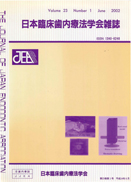19 巻, 1 号
選択された号の論文の9件中1~9を表示しています
- |<
- <
- 1
- >
- >|
原著
-
1998 年 19 巻 1 号 p. 1-4
発行日: 1998年
公開日: 2019/04/30
PDF形式でダウンロード (4501K) -
1998 年 19 巻 1 号 p. 5-9
発行日: 1998年
公開日: 2019/04/30
PDF形式でダウンロード (3367K) -
1998 年 19 巻 1 号 p. 10-15
発行日: 1998年
公開日: 2019/04/30
PDF形式でダウンロード (4775K) -
1998 年 19 巻 1 号 p. 16-23
発行日: 1998年
公開日: 2019/04/30
PDF形式でダウンロード (5843K) -
1998 年 19 巻 1 号 p. 24-30
発行日: 1998年
公開日: 2019/04/30
PDF形式でダウンロード (7096K) -
1998 年 19 巻 1 号 p. 31-37
発行日: 1998年
公開日: 2019/04/30
PDF形式でダウンロード (4522K)
ケースレポート
-
1998 年 19 巻 1 号 p. 54-58
発行日: 1998年
公開日: 2019/04/30
PDF形式でダウンロード (1328K) -
1998 年 19 巻 1 号 p. 59-63
発行日: 1998年
公開日: 2019/04/30
PDF形式でダウンロード (2832K)
メディカルエッセイ
-
1998 年 19 巻 1 号 p. 64-66
発行日: 1998年
公開日: 2019/04/30
PDF形式でダウンロード (2143K)
- |<
- <
- 1
- >
- >|
